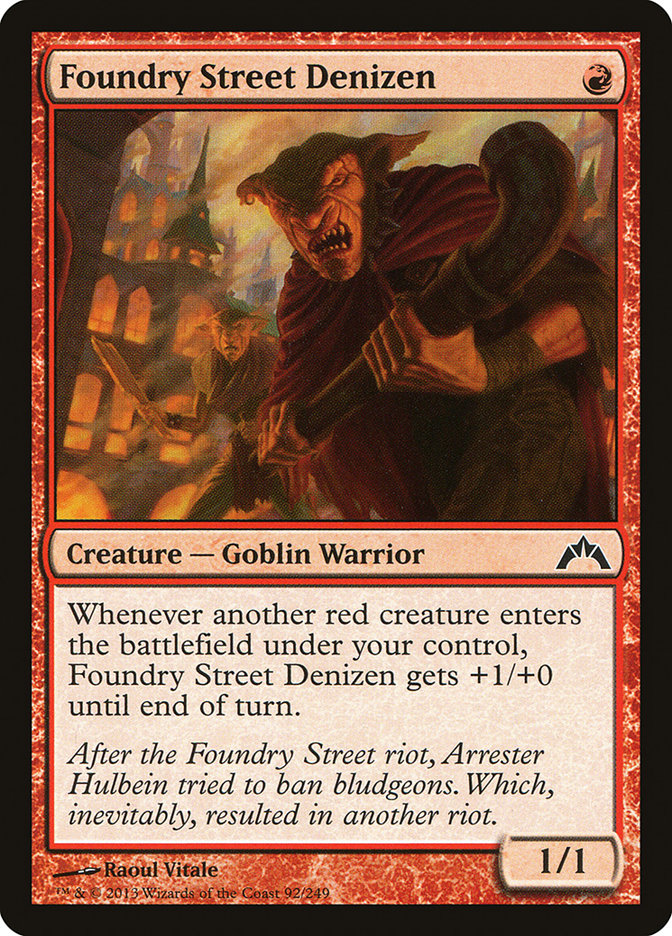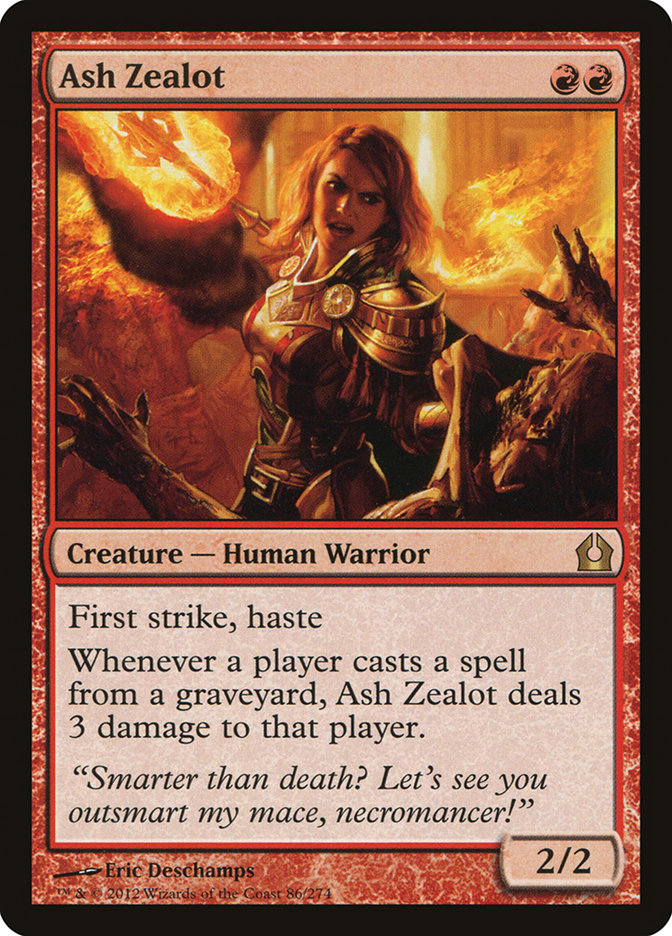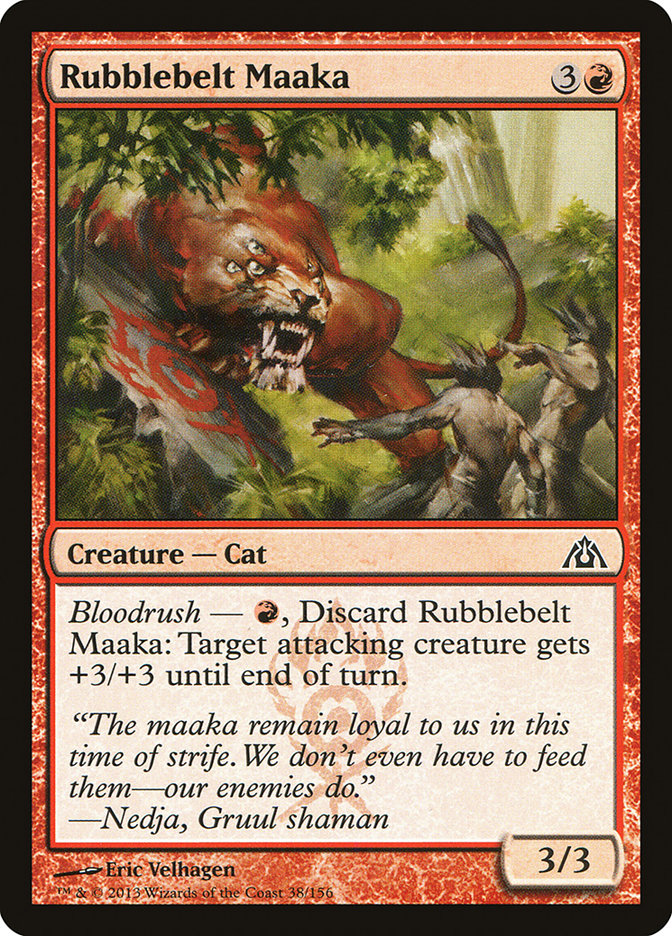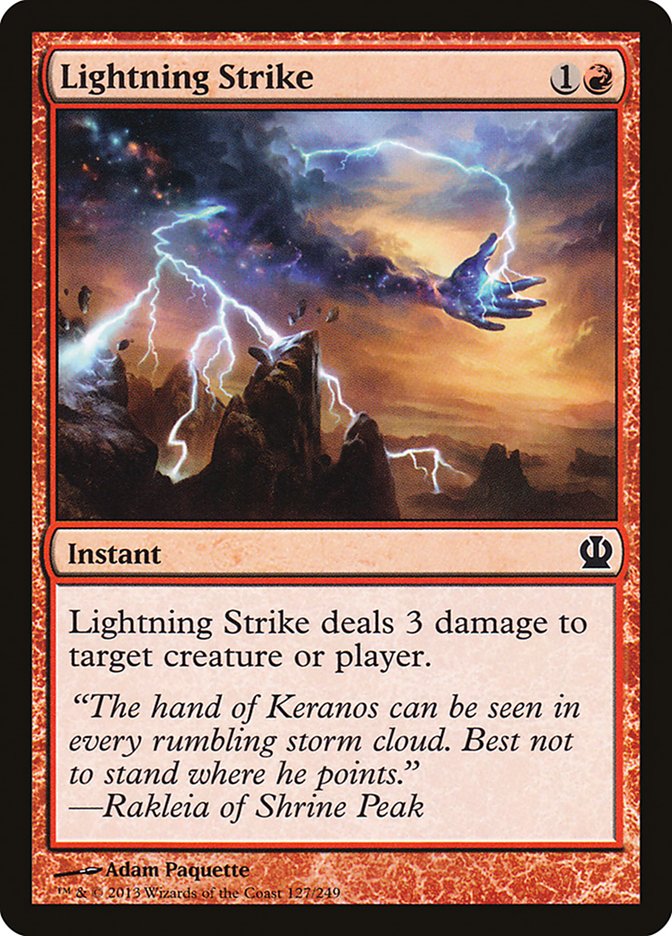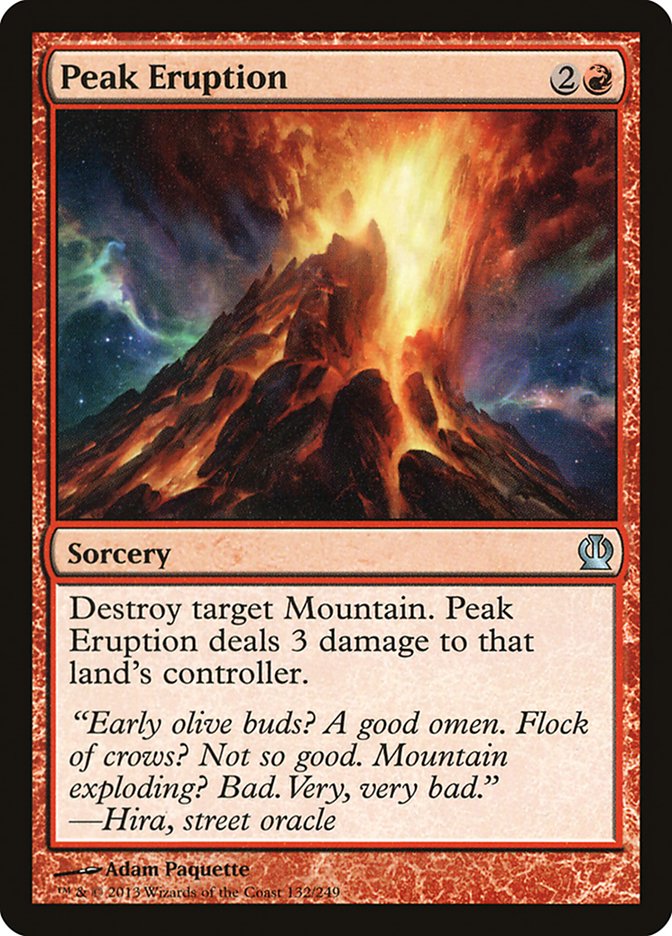When I’m not travelling around the country watching matches of Standard on behalf of StarCityGames.com, I’m at home, usually playing a fair bit of Standard myself. There are a few reasons for this. It helps me stay familiar with all the cards and decks people play and with the general interactions of the format. It aids in keeping my game sharp, which is an asset in the booth as well. Lastly, I enjoy playing Magic in general and this Standard format specifically, and I don’t get the opportunity to play very much anymore given the demands of the road.
Magic Online gives me an outlet for all these needs, and if you log on most evenings Tuesday through Thursday, you’ll see Big Dan Teague giving and receiving beatdowns in eight-person Standard queues and the occasional Daily Event (especially since I’m on a self-imposed drafting hiatus after I got worked in BTT Draft).
I’m usually working on red decks of various persuasions, and my current iteration has about a month’s worth of work put into it at this point. I think deckbuilders generally overrate their own stuff, and I’m self-aware enough to describe my decks as either "good" or "I’m doing this because I’m doing this, but it’s not actually good." This Standard deck is firmly in the first camp, and I posted it on Facebook and Twitter as an option for players competing in the SCG Invitational in Charlotte last weekend.
Chase Kovac played my exact 75 to a 7-1 Standard record and Top 16 finish, and Reuben Bresler posted a 6-2 record and Top 32 finish with 74 of my 75. In the interest of full disclosure, Tannon Grace played my list and caught the bad end of it, but Chase and Reuben both talked to me about playing the deck and validated my initial impression—this thing is for real.
Creatures (32)
- 4 Chandra's Phoenix
- 4 Gore-House Chainwalker
- 4 Rakdos Cackler
- 4 Burning-Tree Emissary
- 4 Firefist Striker
- 4 Foundry Street Denizen
- 4 Rubblebelt Maaka
- 4 Firedrinker Satyr
Lands (22)
Spells (6)
Sideboard

Why would this be good?
I think it’s important for every deckbuilder to answer this question, even if it sounds like an obvious thing to consider. Why would this particular combination of cards be a good choice right now? It’s especially intriguing in the case of red, as the only new inclusion from Born of the Gods is Searing Blood. That card is quite powerful of course, but it isn’t good against every opponent and gets cast against this deck to good effect as well. If red had all the tools before Born of the Gods, why wasn’t it a bigger player during the Mono-Blue Devotion/Mono-Black Devotion/Sphinx’s Revelation metagame of Theros Standard?
It isn’t so much about what red got as it is about what other decks got. The new Temples opened up all sorts of deckbuilding options. Temple of Enlightenment is a powerful enabler for Esper strategies of course and also gives Mono-Blue Devotion the option to splash white for Detention Sphere, as Travis Harrison elected to do en route to winning the Standard Open in Charlotte to kick off Season Two of the Open Series. Since Mono-Blue Devotion regularly loses to Pack Rat; Desecration Demon; and Polukranos, World Eater, Detention Sphere is an attractive option.
Temple of Malice has enabled a variety of splashes, from removal spells for Monsters to Rakdos’s Return in Mono-Black Devotion. These splashes open up some inconsistencies, but the boost in power more than compensates for that in the majority of matchups.
Red is an important exception to "majority of matchups." It’s a reasonable debate if Detention Sphere or Rapid Hybridization is more powerful against red beatdown, but even if it’s Sphere, it isn’t by such a margin that it’s worth putting Hallowed Fountain and Temple of Enlightenment in your deck at the expense of Islands. Ultimate Price and Dreadbore are fine cards against red but by no means worth all the Overgrown Tomb and Blood Crypt Jund Monsters has to cram into the deck to cast them. And a general uptick in Esper is going to be a good thing for red almost no matter what the specifics are.
Besides the consequences of the new Temples, a couple of other things are working in red’s favor. Bile Blight is a powerful spell for Mono-Black Devotion, but it’s much worse against red than the maindeck Pharika’s Cure these decks were playing before. There’s also been a general downward trend of Mono-Red and Mono-Blue Devotion, the two worst matchups for red, in the current Standard environment. Individually each of these changes would mean very little, but collectively they make a huge difference in your win rate. I’ve gone from batting around 50% online with red prior to Born of the Gods to around 75% since.
What follows is a FAQ style list of explanations for various card choices, either because I’m asked about them often or because they’re common points of differentiation from other aggressive red lists.
What’s up with Foundry Street Denizen?
Foundry Street Denizen gets a lot of hate, but I think it’s misplaced. When you have it on the first turn, it will commonly play as a 2/1 for the duration of the game, which is a card you would happily play in this deck, and it can be the most powerful one-drop in the deck in concert with certain Burning-Tree Emissary draws. Also, the entire point of this deck is to capitalize on the inefficiencies most decks are placing upon themselves, so you just need to do something on the first turn. Yes, it can be a pathetic draw on turn 6, but the same thing is true of Rakdos Cackler and Burning-Tree Emissary, which no one talks about cutting from the deck.
There’s also something to be said for being as redundant as possible in a format where Thoughtseize is prevalent. This deck is about as well suited as a deck can be to fight that card, but it can still be a powerful tool when the opponent is on the play. One of the typical scenarios when Thoughtseize is good is when they take your only one-mana creature, so drawing more opening hands with multiple one-drops gives you insurance there as well.
Why Gore-House Chainwalker & no copies of Ash Zealot?
Make no mistake—this is a Burning-Tree Emissary deck first and foremost. For my money, it’s the fourth most powerful card in Standard (behind Mutavault, Thoughtseize, and Sphinx’s Revelation in that order), and Gore-House Chainwalker is the most powerful card you can play off of Emissary. There are only eighteen Mountains in the deck as well, so it isn’t the most reliable card to cast on the second turn regardless. The same thing is true of Burning-Tree Emissary and Searing Blood, but Ash Zealot is far less powerful than Emissary and much more time sensitive than Searing Blood.
Even if it weren’t for Burning-Tree Emissary, there would still be arguments for Chainwalker. It’s much more effective at fighting Sylvan Caryatid and Jace, Architect of Thought, two problematic cards for red decks in general. Nightveil Specter is also annoying on occasion, and Chainwalker can do good work there as well.
Why play Rubblebelt Maaka at all or over Titan’s Strength?
Many decks in Standard can outclass you on the ground. Sylvan Caryatid, Courser of Kruphix, Scavenging Ooze, Frostburn Weird—the list of quality blockers goes on and on. Alongside Firefist Striker and some removal, Rubblebelt Maaka gives you a good shot at beating these cards, which is of critical importance because they are quite good against you.
I anticipated Maaka being bad against decks like Esper and U/W Control, but even there Maaka pulled its weight. It’s a helpful tool in fighting Jace, Architect of Thought; Blood Baron of Vizkopa; Archangel of Thune; and Fiendslayer Paladin and can usually be cashed in as a Lava Spike in the worst-case scenario (and any game where this isn’t the case probably means you are losing by such a margin that a different card wouldn’t make much of a difference). I keep in all four copies against Revelation decks, which is telling.
I have played Titan’s Strength on occasion. Scrying is nice, and it can be used on defense and is a great answer to Domestication. But right now I prefer Maaka for the following reasons:
- Many of your creatures have one toughness, which means your creature dies (instead of survives) against Courser of Kruphix and Nightveil Specter and your creatures can’t attack (instead of freely attacking) into two-power first strikers like Ash Zealot, Fiendslayer Paladin, and Precinct Captain.
- Given the state of the metagame, maindeck Duress is picking up in popularity, so keeping the spell count low is nice.
- Maaka can’t be countered, which comes up a fair bit against Esper and U/W Control.
- You can cast Maaka as a creature, which isn’t the best but does come up against removal-heavy draws from Mono-Black Devotion (which is a place where Titan’s Strength is horrible).
The first reason is the biggest of them all, but all the other factors come up as well. I could see Titan’s Strength being superior in a first-strike-heavy build featuring Legion Loyalist and Ash Zealot (or in concert with creatures like Young Pyromancer or Akroan Crusader), but given the nature of the creature base, I think Maaka is much better.
The removal numbers look weird. Also, no Lightning Strike?
The list initially started with four copies of Shock and two copies of Lightning Strike, but Lightning Strike underperformed. It was nice against Nightveil Specter, and the flexibility is great. But I lost enough games to Courser of Kruphix; Brimaz, King of Oreskos; Blood Baron of Vizkopa; Frostburn Weird; Gray Merchant of Asphodel; Scavenging Ooze; and Archangel of Thune to want to put a few Mizzium Mortars in the maindeck. When they were in my sideboard, I was boarding in two against nearly every opponent anyway, so starting two felt low cost.
The playset of Shock eventually became a playset of Searing Blood because that card is busted, but I drew too many hands that couldn’t cast Searing Blood early and was falling behind aggressive decks when I was on the draw. There’s also something to be said for playing the cheapest cards when your mana is tied up in things like Mutavault, Rubblebelt Maaka, and Firedrinker Satyr. I like having the ability to board up to four copies of Searing Blood when appropriate (as again, the card is busted), but a couple of maindeck Shock is a concession to mana curve game 1, when you’re trying to be as fast as possible against most opponents.
Seems like a lot of Peak Eruption in the board. Isn’t it narrow?
It is, but it’s the highest-impact sideboard card that red has. Mono-Red Devotion is a horror show of a matchup game 1, and R/W Burn is close but harrowing and quite prevalent. It’s really hard for them to win the game if you Peak Eruption them on turn 3 or if you blow up a land with Chained to the Rocks on it. This is especially the case against R/W Burn since their best tool against you is Warleader’s Helix, which they often can’t cast at all if you Stone Rain them once. If anything, I would want a fourth copy in the board replacing a copy of Boros Reckoner, as you’re often bringing it in alongside Peak Eruption and can only afford so many three-mana cards.
The short synopsis is that I’ve been winning a lot with this deck and many other people have been as well. While I’m not thrilled about the prospect of Staff of the Death Magus picking up in popularity, you have a lot more potential to slog through that card than R/W Burn does, and the rest of the metagame is pretty favorable. As long as people are committed to messing around with a lot of nonbasic lands, I highly recommend this list or something very close to it.

